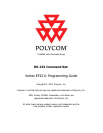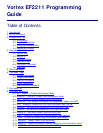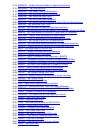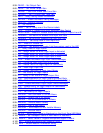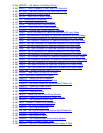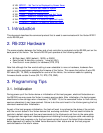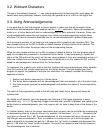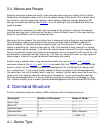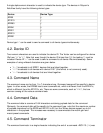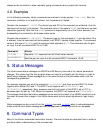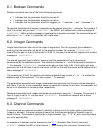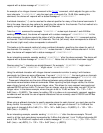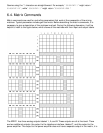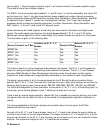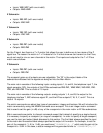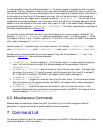
8.149. SSTEXT -- Set Text to be Displayed by Screen Saver
8.150.
SWRESET -- Perform Soft Reset of System
8.151.
SWVER -- Query Software Version
8.152.
TONEE -- Enable or Disable Entry and Exit Tones
8.153.
TONER -- Enable or Disable Ring Tones
8.154.
VTXMODI -- Enable VTX Mode on Specified Inputs
8.155.
VTXMODO -- Enable VTX Mode on Specified Inputs
1. Introduction
This document describes the command protocol that is used to communicate with the Vortex EF2211
via its RS-232 port.
2. RS-232 Hardware
The communication between the Vortex and a host controller is conducted via the RS-232 port on the
back panel of the Vortex. The Vortex's RS-232 port operates at the following settings:
● Bit Rate (bps): 9600 (default), 19200, or 38400
● Data Format: 8 data bits, no parity, 1 stop bit (8N1)
● Flow Control: none (default) or hardware (RTS, CTS)
Note that although the flow control setting is user selectable to none or hardware, hardware flow
control must be used when updating the firmware of the Vortex. This means that while a 3-wire RS-
232 cable (RX, TX, GND) is acceptable for control of the Vortex, the minimum cable for updating
firmware should contain 5 wires (RX, TX, RTS, CTS, GND).
3. Programming Tips
3.1. Initialization
During power up of the Vortex device or initialization of the host program, electrical fluctuations on
the RS-232 lines may cause the Vortex to receive spurious data. After initialization, the host program
should send a few carriage return characters (^M, ASCII 13) to the connected Vortex to flush out any
spurious characters it may have received. Failure to do this could result in the Vortex ignoring the first
command received after initialization.
As part of the host program initialization, the host will want to synchronize the status of its controls
with the current status of the Vortex devices that are being controlled. The host could initialize its
controls to default values and then send commands to the Vortexes to set them to the same state.
This approach has significant disadvantages since initializing the host program could undo settings
made by other host programs or by the front panel controls of one of the linked Vortex devices. A
better approach is to query the linked Vortex devices for their status and set the host program
controls based on the return values.



